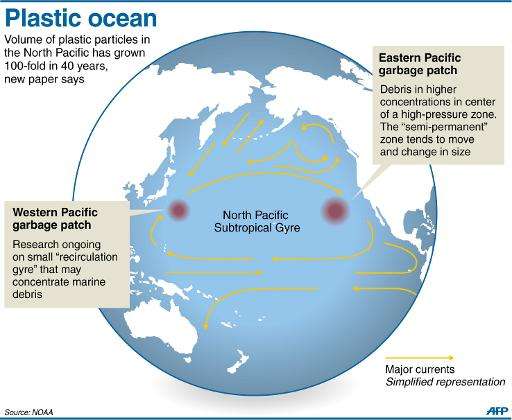Graphic showing the North Pacific Subtropical Gyre (NPSG) where plastic waste has increased 100-fold over the last 40 years
Researchers are launching tests aimed at setting up a huge floating barrier off the Japanese coast, a project that could eventually help remove some of the 5.25 trillion pieces of rubbish polluting the world's oceans, officials said Thursday.
If the study is a success, the southern island of Tsushima could be the venue for a pilot scheme that would pluck tonnes of plastic waste from the sea—all without harming marine life.
The Ocean Cleanup Foundation wants to install a moored platform and floating boom off the island next year if the tests, which begin this month, prove promising.
The system would span 2,000 meters (6,600 feet), making it the longest floating structure ever deployed in the ocean, according to the Dutch foundation's website.
Most ocean clean-up efforts involve the use of boats sailing around trying to catch the plastic, thousands of tonnes of which have been dumped around the world.
That method is both energy-intensive and time-consuming, whereas the Ocean Cleanup Foundation system relies on taking advantage of currents that carry rubbish along—effectively waiting for the garbage to come to it.
Since the system uses booms, not nets, marine life—which is neutrally buoyant—passes harmlessly underneath the barriers, while plastic—which floats—is gathered at the surface.
Workers can then scoop up the collected detritus, with island authorities looking at using the plastic as an alternative energy source.
Ocean garbage washing up on the shore has long been a problem for Tsushima, which sits between Kyushu and South Korea, costing millions of dollars a year to deal with.
"We are picking it up but no matter what we do, it keeps on coming," said Takahito Abiru, an environmental policy official in Tsushima.
"We are collecting garbage in fishing grounds, at tourist places, on beaches and elsewhere, but there are other areas that are not so easy to access," he told AFP.
"If we could stop the garbage offshore, we'd appreciate it."
The city will make a final decision on whether to approve the deployment of the system after seeing results of the upcoming marine survey and obtaining consent from fishermen and local residents.
The survey will start in late June and will take account of the depth of the sea, the shape of the seabed and tidal currents, Abiru said.
"We will decide possibly by February whether it can be installed or not," he said, adding there had been no local opposition to conducting the study.
The deployment would represent an important step for The Ocean Cleanup, which ultimately envisions a much larger solution to a problem that increasingly plagues the world's oceans.
The organisation, which was started by a Dutch teenager, aims to deploy a 100-kilometre (62-mile) long system to clean up the sea between Hawaii and California within five years—the location of the so-called "Great Pacific Garbage Patch", a major gyre of marine debris.
The deployment off Tsushima will enable the foundation to "study the system's efficiency and durability over time," 20-year-old chief executive Boyan Slat said on the foundation's website.
© 2015 AFP























